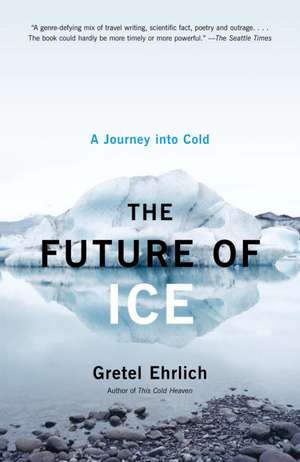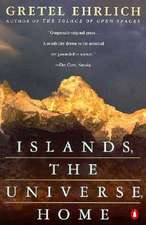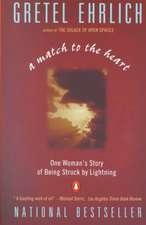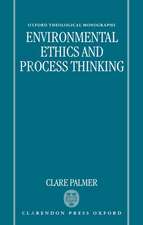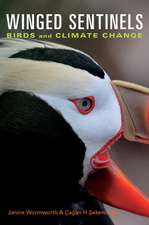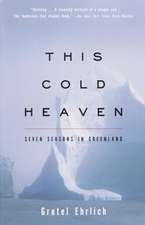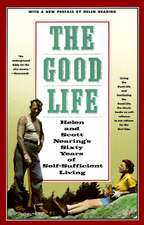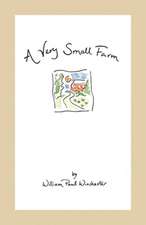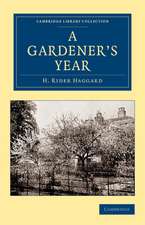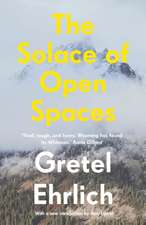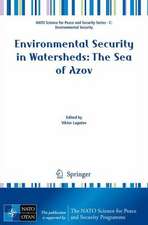The Future of Ice: A Journey Into Cold
Autor Gretel Ehrlichen Limba Engleză Paperback – 31 oct 2005
Over the course of a year, Ehrlich experiences firsthand the myriad expressions of cold, giving us marvelous histories of wind, water, snow, and ice, of ocean currents and weather cycles. From Tierra del Fuego in the south to Spitsbergen, east of Greenland, at the very top of the world, she explores how our very consciousness is animated and enlivened by the archaic rhythms and erupting oscillations of weather. We share Ehrlich’s experience of the thrills of cold, but also her questions: What will happen to us if we are “deseasoned”? If winter ends, will we survive?
Preț: 101.99 lei
Nou
Puncte Express: 153
Preț estimativ în valută:
19.52€ • 20.30$ • 16.11£
19.52€ • 20.30$ • 16.11£
Carte disponibilă
Livrare economică 25 martie-08 aprilie
Preluare comenzi: 021 569.72.76
Specificații
ISBN-13: 9781400034352
ISBN-10: 1400034353
Pagini: 200
Dimensiuni: 135 x 203 x 17 mm
Greutate: 0.24 kg
Editura: Vintage Books USA
ISBN-10: 1400034353
Pagini: 200
Dimensiuni: 135 x 203 x 17 mm
Greutate: 0.24 kg
Editura: Vintage Books USA
Notă biografică
Gretel Ehrlich is the author of This Cold Heaven and The Solace of Open Spaces, among other works of nonfiction, fiction, and poetry. She divides her time between California and Wyoming.
Extras
TIERRA DEL FUEGO
The straight course is hacked out in rounds against the will of the world.
—D. H. LAWRENCE
January. Perpetual freshness, raw cliffs, a leggy forest, an unpolished sun: that’s what I’ve come to love about the end of the world, the uttermost part of the earth, latitude 55 degrees south, last stop before Antarctica. Up under the eaves at the torn end of the Andean cordillera, snow blasts rock walls white and a hanging glacier crumbles. Ocean ends. Ice recedes. Time sweeps upward in the form of southern beech trees; wind rams it back down.
I’ve come here to hike a seventy-mile circuit in the southern Andes. It’s summer but it feels like winter. The trees are bent as if picking up something that had fallen. There is no sunrise, no moonrise, no sighting of the Southern Cross, only storms braiding and unbraiding themselves.
Lately my travels have mimicked the high-altitude circumpolar routes taken by arctic and antarctic birds—south polar skuas, great skuas, long-tailed jaegers, sanderlings, and arctic terns. While we travel the same routes, we are seeking different kinds of weather: they are driven by a tight summer-and-light-seeking schedule ordered by magnetic field lines and sun-compass routes; I’m looking for cold, meandering through wintry landscapes when and where I find them, trying to see if the season of winter is shrinking, and why.
Morning. A single blade of light rays down. I walk the length of the natural harbor below Ushuaia. The town hangs on a hill backed by green peaks. A glut of birds sweeps overhead. Gray-headed albatrosses cross paths with ones that are black-browed, and these pass giant petrels and southern fulmars, as three olivaceaous cormorants flap hard on the water below. Straight south, somewhere between Drake Passage and the South Sandwich Trench, a couple of arctic terns I saw nesting at the very top of Greenland, near Warming Land, have just completed their 107-day trip to these southern waters in search of a twenty-four-hour sun. But here they’re getting winter minus the darkness: rain turns to sleet, and in the direction of Cape Horn there is a whiteout of summer snow.
Before me is the historic Beagle Channel, named for the ship that brought young Charles Darwin here, to el fin del mundo. It was just before Christmas in 1832 that the HMS Beagle turned into the Strait of Le Maire, then the channel. It is a fragment of South Atlantic water into which Drake, Ross, Cook, Fitzroy, Darwin, Joshua Slocum, and Rockwell Kent, among many others, sailed. They were searching for passage to Asia, looking for gold, or just looking.
This coast was once home to the Yamana Indians, who traveled these rough waters by bark canoe. In the mountains behind Ushuaia lived the Selk’nam (also known as Ona) Indians, guanaco-robed hunters of the harsh Fuegean mountains and plains, whom the Yamana feared.
Today the channel is stippled with whitecaps, the bitterness of vanquished Indians still washing up on its shores. “Is right here everything end,” Derek Walcott’s Odyssean figure said. What ended was a time when there seemed to be room enough for everyone.
Now the odyssey we human beings in the “developed world” have embarked upon is almost too darkly insane to contemplate. The scandal of “improvement” has meant that we’ve reduced the parallel worlds of spirit, imagination, and daily life to a single secularized lump. The process of empire building is a kind of denigration. Nothing that’s not nuts and bolts and money-making is allowed in.
My toes curl over the edge of the continent dipping into almost freezing water. The westerlies howl. The sea is all slivers and splints, straits and rocky knobs, shinbones and arm bones, hermit islands jutting into desolation bays, as if the history of this place, with its hundreds of shipwrecks and decimated native cultures, were imitating landscape. Or is it the other way around?
“Kik, kik, kik, kik,” the terns cry. They will feed and rest here for two months before flying north again. Down here, Argentina and Chile are pinched so tightly together there is almost no land, just peaks, sky strips, and rough water. Evening comes late (it’s summer, after all), but a storm-made twilight lasts all day.
Looking out over the famous channel, I think of the tectonic convulsions and hard draughts of heat and ice that have shaped this place and the cold-adapted people who lived here; how beauty in both landscape and culture came from those difficulties. I’m wandering around, trying to connect that which is at the end of the world with the way seasons, ice ages, warm spells, birds, and human thought travel in circles.
Darwin saw Yamana canoes crisscrossing the channel and moving though the labyrinth of inlets and islands. The canoes were built to withstand heavy seas. High-sided, they were made of bark cut from the coihue tree using the long leg bone of the guanaco for a saw, and sewn together with whale sinew strung on whalebone needles.
A canoe lasted for a year. The men were stationed in the bow with harpoons and spears to hunt seals, while the women navigated and paddled. Because it was always cold, the children were placed midboat to tend small fires made from dried grass plants, roots up, stuck into a pile of sand. Smoke was seen coming from every canoe in the channel as well as on every strip of sand.
Rain, wind, or snow was constant, but the Yamana went naked, smearing their bodies with seal and whale grease. They said it was too wet to wear clothes. Their ceremonial dances had the sea in them: the shaman wore a headdress of white bird down meant to look like the foam on a cresting wave. When the people danced, they held sticks horizontally and moved them back and forth, up and down, to represent the movement of the sea.
In the mountains behind Ushuaia, the floor of the valley is bog and peat. Yamana canoe portages were made of felled trees. The logs were laid side by side, sometimes for one thousand feet—a shortcut over soupy ground on which they could carry their canoes or simply walk to distant bays.
Back in the mountains the terrain gets rough and the bogs get deeper. Lakes lie between timbered slopes. The Selk’nam and Haush Indians who lived here hunted their way from one coast to the other. Each time they stopped and built a hut to perform their annual rite, the kina ceremony, they said the surface of the ground actually changed: from steep slopes and deep bogs into sunny meadows. It wasn’t the spirit doing this, they said, but the ceremony itself that made the earth change.
The Selk’nam had four skies. Each was thought to be invisible and infinite, constituting a whole cordillera. Where they lived was a place of mountains, and they conceived of sky, ocean, and weather as being mountains as well.
The north sky was black, associated with rain, the sea, and the whale. The west was red, made of wind and sun. The east was only a boiling sea, and the south was pure white because that’s where the snow came from, and the moon and the owl. These most southerly cultures in the world had winter weather threaded all through them. When asked about who her parents were, one Selk’nam woman said: “I am snow, my mother was wind, my father, rain.”
The life of rocks, ice, mountains, snow, oceans, islands, albatross, sooty gulls, whales, seals, crabs, limpets, and guanaco once flowed up into the bodies of these people, and out came whale prayers, condor chants, crab feasts, and guanaco songs. Life went where there was food. Villages were portable. Food occurred in places of great beauty, and the feedback from living directly fueled their movements, dances, thoughts, and lives.
Everything spoke: birds, ghosts, animals, oceans, bogs, rocks, humans, trees, and rivers; everything made a sound, and when they passed one another, a third sound occurred. That’s why weather, glaciers, and each passing season were so noisy. Song and dance, sex and gratitude were the season-sensitive ceremonies that linked the human psyche to the larger, wild, weather-ridden world.
When did we begin thinking that weather was something to be rescued from? Why did we trade in our ceremonial lives for the workplace? Is this a natural progression, or a hiccup in human civilization that we’ll soon renounce? The chiexaus initiation ceremony of the Yamana might last two or three months, and the hain initiation ceremony of the Selk’nam sometimes lasted a year, depending on their food supply. In their reckoning, one whale equaled one year.
By the early 1890s vast tracts of Selk’nam and Haush land had been given as land grants by the Argentine government to missionaries as well as land-hungry farmers from the United Kingdom and Europe, who systematically killed, kidnapped, and incarcerated Selk’nam people. One Ona shaman, named Hektliohlh, was detained for years at the Silesean Mission on Dawson Island. When he looked toward his mountain home he said: “Shouwe t-maten ya,” the longing is killing me. Then he died. No pure-blood Ona, Yamana, or Haush are left today.
TORRES DEL PAINE, CHILE
Wild daisies and lenga trees and the winding, milk-green rivers emanating from glaciers. I’ve been joined by Gary, a friend from Montana, and we are walking. Glaciers have shaped roughly a third of the land area of the planet. How could they not shape the way we move and think, honed as we are, on sharp arêtes, domed cliffs, and the U-shaped valleys between, the floury rivers and string lakes held tight in steep canyons? The southern Andes carry more glacier ice than any other area in the world outside the North and South Poles.
That’s why Gary and I are backpacking a seventy-mile circular route in Chile’s Torres del Paine National Park. Here the granite batholiths—huge towers—are rock teeth belonging to a wrathful deity from whom perpetual storms spray.
Our backpacks are heavy—mine is fifty-five pounds, and Gary’s weighs in at eighty-five. The wind is against us as we head up a steep rise. In my Spanish dictionary the word senda means not only “a path,” but also “a ways and means,” while the masculine, sendero, is only “a footpath”—nothing more. Yet the verb, senderear, means “to conduct along a path,” and also “to attain by tortuous means.” Perfect. We follow the Paine circuit counterclockwise, and as the days go on, I refer to it both as a path that passes with no end in itself and as a circuit of pain. Not just my bodily pain, which at times is considerable, but also the one implied by any circular route consciously taken. Perhaps circle is the wrong word. A wheel with broken spokes might be better, or a body following its feet around.
We walk from Hosteria Las Torres, along Río Paine. The sun slides up vertical sweeps and down into U-shaped valleys, giving itself to unraveling storms. The river goes dark, then brightens to a dull celadon. Storm shadows tint tree shadows. Rain shatters and stutters; guanacos graze. Patchworks of ice—the remains of hanging glaciers—rot away before our eyes. Snow squalls fall flat like bedsheets. As we walk through them, they erase both the sendero and the senda—the path as well as the ways and means. Later, as we go over a pass, an eighty-mile-per-hour wind tips us over. Laughing, we get to our feet and look up: a pair of Andean condors—whose wings, stretched out, are as long as two of me—jump off the cliff above us, a jutting arête, and float effortlessly.
At the end of the first day, before reaching Campamento Serón, we climb onto a flat bench of land, a mesita with foot-wide streams and stacked mogotes—plants that look like huge pincushions made of yellow flowers growing on hills. A herd of thirty loose horses clatters by on the trail below, pushed by four pantalooned gauchos wearing neck scarves, dark glasses, and berets. The faster the horses go, the more the men laugh. They don’t see us; we climb higher. Finally I lay my pack down, get on my knees, and come face-to-face with a rare Magellan orchid, its slightly curled petals cream, yellow, and veined green.
Gary takes off trotting. Lithe and youthful, he jumps straight-legged from one precipice to another. We met by chance in the mountains of Wyoming and talked for fifteen minutes, then didn’t see each other again. I dreamt about him. Same dream each time: he was in a cabin; I walked by outside; he looked at me with his green eyes. Three months later he asked a mutual friend for my phone number and called. Another five months went by and many conversations before he showed up at my door.
My eyes open; Gary is gone, but one, then two, then four condors lift off and soar across the river valley. Their bald heads and white ermine collars move, but not their wings. Instead, they let themselves be moved, using their wings, oh so gently, only to change altitude. To move without effort, that’s what I need to learn. I look up and see a scratched mountain memory: a glacier’s claw mark across a face of rock.
Gary comes back with a condor feather: a gift for me. It is long and black, its rachis thick and sturdy. Rain comes and continues all night; I dip the quill into it and write.
The gauchos return for more horses, their laughter rising and fading as they disappear. We ponder the word Paine—for the circuit we’re walking—is it a Telemache word meaning “blue,” or the name of a Welsh climber who scaled a nearby peak? I know few names here. So many birds, grasses, flowers, mountains, and trees . . .
Sleep comes easily. I’m still tired from traveling and a recent bout of the flu. In the morning I roll the feather in my sleeping pad, hoist my backpack, and reluctantly hit the trail. Oh, for feathers and wings! Effortless is not how I’d describe my movements in the days that follow. Gary and I walk at such different speeds that I see little of him, and for the first time the age difference between us seems appalling. I trudge and saunter, wipe sweat from my face, and laugh at the poorly working parts of my body, while he’s all grace and exuberance. Usually an hour ahead, he comes back and carries my pack the last half mile because he’s a fair-minded man and is always looking for ways to make our differences equal. At the end of each day we pitch camp, eat soup, drink tea, share chocolate, and happily compare notes: who saw what flower, grass, waterfall, bee, or bird, and how speed or slowness brought these gifts to our eyes.
From the Hardcover edition.
The straight course is hacked out in rounds against the will of the world.
—D. H. LAWRENCE
January. Perpetual freshness, raw cliffs, a leggy forest, an unpolished sun: that’s what I’ve come to love about the end of the world, the uttermost part of the earth, latitude 55 degrees south, last stop before Antarctica. Up under the eaves at the torn end of the Andean cordillera, snow blasts rock walls white and a hanging glacier crumbles. Ocean ends. Ice recedes. Time sweeps upward in the form of southern beech trees; wind rams it back down.
I’ve come here to hike a seventy-mile circuit in the southern Andes. It’s summer but it feels like winter. The trees are bent as if picking up something that had fallen. There is no sunrise, no moonrise, no sighting of the Southern Cross, only storms braiding and unbraiding themselves.
Lately my travels have mimicked the high-altitude circumpolar routes taken by arctic and antarctic birds—south polar skuas, great skuas, long-tailed jaegers, sanderlings, and arctic terns. While we travel the same routes, we are seeking different kinds of weather: they are driven by a tight summer-and-light-seeking schedule ordered by magnetic field lines and sun-compass routes; I’m looking for cold, meandering through wintry landscapes when and where I find them, trying to see if the season of winter is shrinking, and why.
Morning. A single blade of light rays down. I walk the length of the natural harbor below Ushuaia. The town hangs on a hill backed by green peaks. A glut of birds sweeps overhead. Gray-headed albatrosses cross paths with ones that are black-browed, and these pass giant petrels and southern fulmars, as three olivaceaous cormorants flap hard on the water below. Straight south, somewhere between Drake Passage and the South Sandwich Trench, a couple of arctic terns I saw nesting at the very top of Greenland, near Warming Land, have just completed their 107-day trip to these southern waters in search of a twenty-four-hour sun. But here they’re getting winter minus the darkness: rain turns to sleet, and in the direction of Cape Horn there is a whiteout of summer snow.
Before me is the historic Beagle Channel, named for the ship that brought young Charles Darwin here, to el fin del mundo. It was just before Christmas in 1832 that the HMS Beagle turned into the Strait of Le Maire, then the channel. It is a fragment of South Atlantic water into which Drake, Ross, Cook, Fitzroy, Darwin, Joshua Slocum, and Rockwell Kent, among many others, sailed. They were searching for passage to Asia, looking for gold, or just looking.
This coast was once home to the Yamana Indians, who traveled these rough waters by bark canoe. In the mountains behind Ushuaia lived the Selk’nam (also known as Ona) Indians, guanaco-robed hunters of the harsh Fuegean mountains and plains, whom the Yamana feared.
Today the channel is stippled with whitecaps, the bitterness of vanquished Indians still washing up on its shores. “Is right here everything end,” Derek Walcott’s Odyssean figure said. What ended was a time when there seemed to be room enough for everyone.
Now the odyssey we human beings in the “developed world” have embarked upon is almost too darkly insane to contemplate. The scandal of “improvement” has meant that we’ve reduced the parallel worlds of spirit, imagination, and daily life to a single secularized lump. The process of empire building is a kind of denigration. Nothing that’s not nuts and bolts and money-making is allowed in.
My toes curl over the edge of the continent dipping into almost freezing water. The westerlies howl. The sea is all slivers and splints, straits and rocky knobs, shinbones and arm bones, hermit islands jutting into desolation bays, as if the history of this place, with its hundreds of shipwrecks and decimated native cultures, were imitating landscape. Or is it the other way around?
“Kik, kik, kik, kik,” the terns cry. They will feed and rest here for two months before flying north again. Down here, Argentina and Chile are pinched so tightly together there is almost no land, just peaks, sky strips, and rough water. Evening comes late (it’s summer, after all), but a storm-made twilight lasts all day.
Looking out over the famous channel, I think of the tectonic convulsions and hard draughts of heat and ice that have shaped this place and the cold-adapted people who lived here; how beauty in both landscape and culture came from those difficulties. I’m wandering around, trying to connect that which is at the end of the world with the way seasons, ice ages, warm spells, birds, and human thought travel in circles.
Darwin saw Yamana canoes crisscrossing the channel and moving though the labyrinth of inlets and islands. The canoes were built to withstand heavy seas. High-sided, they were made of bark cut from the coihue tree using the long leg bone of the guanaco for a saw, and sewn together with whale sinew strung on whalebone needles.
A canoe lasted for a year. The men were stationed in the bow with harpoons and spears to hunt seals, while the women navigated and paddled. Because it was always cold, the children were placed midboat to tend small fires made from dried grass plants, roots up, stuck into a pile of sand. Smoke was seen coming from every canoe in the channel as well as on every strip of sand.
Rain, wind, or snow was constant, but the Yamana went naked, smearing their bodies with seal and whale grease. They said it was too wet to wear clothes. Their ceremonial dances had the sea in them: the shaman wore a headdress of white bird down meant to look like the foam on a cresting wave. When the people danced, they held sticks horizontally and moved them back and forth, up and down, to represent the movement of the sea.
In the mountains behind Ushuaia, the floor of the valley is bog and peat. Yamana canoe portages were made of felled trees. The logs were laid side by side, sometimes for one thousand feet—a shortcut over soupy ground on which they could carry their canoes or simply walk to distant bays.
Back in the mountains the terrain gets rough and the bogs get deeper. Lakes lie between timbered slopes. The Selk’nam and Haush Indians who lived here hunted their way from one coast to the other. Each time they stopped and built a hut to perform their annual rite, the kina ceremony, they said the surface of the ground actually changed: from steep slopes and deep bogs into sunny meadows. It wasn’t the spirit doing this, they said, but the ceremony itself that made the earth change.
The Selk’nam had four skies. Each was thought to be invisible and infinite, constituting a whole cordillera. Where they lived was a place of mountains, and they conceived of sky, ocean, and weather as being mountains as well.
The north sky was black, associated with rain, the sea, and the whale. The west was red, made of wind and sun. The east was only a boiling sea, and the south was pure white because that’s where the snow came from, and the moon and the owl. These most southerly cultures in the world had winter weather threaded all through them. When asked about who her parents were, one Selk’nam woman said: “I am snow, my mother was wind, my father, rain.”
The life of rocks, ice, mountains, snow, oceans, islands, albatross, sooty gulls, whales, seals, crabs, limpets, and guanaco once flowed up into the bodies of these people, and out came whale prayers, condor chants, crab feasts, and guanaco songs. Life went where there was food. Villages were portable. Food occurred in places of great beauty, and the feedback from living directly fueled their movements, dances, thoughts, and lives.
Everything spoke: birds, ghosts, animals, oceans, bogs, rocks, humans, trees, and rivers; everything made a sound, and when they passed one another, a third sound occurred. That’s why weather, glaciers, and each passing season were so noisy. Song and dance, sex and gratitude were the season-sensitive ceremonies that linked the human psyche to the larger, wild, weather-ridden world.
When did we begin thinking that weather was something to be rescued from? Why did we trade in our ceremonial lives for the workplace? Is this a natural progression, or a hiccup in human civilization that we’ll soon renounce? The chiexaus initiation ceremony of the Yamana might last two or three months, and the hain initiation ceremony of the Selk’nam sometimes lasted a year, depending on their food supply. In their reckoning, one whale equaled one year.
By the early 1890s vast tracts of Selk’nam and Haush land had been given as land grants by the Argentine government to missionaries as well as land-hungry farmers from the United Kingdom and Europe, who systematically killed, kidnapped, and incarcerated Selk’nam people. One Ona shaman, named Hektliohlh, was detained for years at the Silesean Mission on Dawson Island. When he looked toward his mountain home he said: “Shouwe t-maten ya,” the longing is killing me. Then he died. No pure-blood Ona, Yamana, or Haush are left today.
TORRES DEL PAINE, CHILE
Wild daisies and lenga trees and the winding, milk-green rivers emanating from glaciers. I’ve been joined by Gary, a friend from Montana, and we are walking. Glaciers have shaped roughly a third of the land area of the planet. How could they not shape the way we move and think, honed as we are, on sharp arêtes, domed cliffs, and the U-shaped valleys between, the floury rivers and string lakes held tight in steep canyons? The southern Andes carry more glacier ice than any other area in the world outside the North and South Poles.
That’s why Gary and I are backpacking a seventy-mile circular route in Chile’s Torres del Paine National Park. Here the granite batholiths—huge towers—are rock teeth belonging to a wrathful deity from whom perpetual storms spray.
Our backpacks are heavy—mine is fifty-five pounds, and Gary’s weighs in at eighty-five. The wind is against us as we head up a steep rise. In my Spanish dictionary the word senda means not only “a path,” but also “a ways and means,” while the masculine, sendero, is only “a footpath”—nothing more. Yet the verb, senderear, means “to conduct along a path,” and also “to attain by tortuous means.” Perfect. We follow the Paine circuit counterclockwise, and as the days go on, I refer to it both as a path that passes with no end in itself and as a circuit of pain. Not just my bodily pain, which at times is considerable, but also the one implied by any circular route consciously taken. Perhaps circle is the wrong word. A wheel with broken spokes might be better, or a body following its feet around.
We walk from Hosteria Las Torres, along Río Paine. The sun slides up vertical sweeps and down into U-shaped valleys, giving itself to unraveling storms. The river goes dark, then brightens to a dull celadon. Storm shadows tint tree shadows. Rain shatters and stutters; guanacos graze. Patchworks of ice—the remains of hanging glaciers—rot away before our eyes. Snow squalls fall flat like bedsheets. As we walk through them, they erase both the sendero and the senda—the path as well as the ways and means. Later, as we go over a pass, an eighty-mile-per-hour wind tips us over. Laughing, we get to our feet and look up: a pair of Andean condors—whose wings, stretched out, are as long as two of me—jump off the cliff above us, a jutting arête, and float effortlessly.
At the end of the first day, before reaching Campamento Serón, we climb onto a flat bench of land, a mesita with foot-wide streams and stacked mogotes—plants that look like huge pincushions made of yellow flowers growing on hills. A herd of thirty loose horses clatters by on the trail below, pushed by four pantalooned gauchos wearing neck scarves, dark glasses, and berets. The faster the horses go, the more the men laugh. They don’t see us; we climb higher. Finally I lay my pack down, get on my knees, and come face-to-face with a rare Magellan orchid, its slightly curled petals cream, yellow, and veined green.
Gary takes off trotting. Lithe and youthful, he jumps straight-legged from one precipice to another. We met by chance in the mountains of Wyoming and talked for fifteen minutes, then didn’t see each other again. I dreamt about him. Same dream each time: he was in a cabin; I walked by outside; he looked at me with his green eyes. Three months later he asked a mutual friend for my phone number and called. Another five months went by and many conversations before he showed up at my door.
My eyes open; Gary is gone, but one, then two, then four condors lift off and soar across the river valley. Their bald heads and white ermine collars move, but not their wings. Instead, they let themselves be moved, using their wings, oh so gently, only to change altitude. To move without effort, that’s what I need to learn. I look up and see a scratched mountain memory: a glacier’s claw mark across a face of rock.
Gary comes back with a condor feather: a gift for me. It is long and black, its rachis thick and sturdy. Rain comes and continues all night; I dip the quill into it and write.
The gauchos return for more horses, their laughter rising and fading as they disappear. We ponder the word Paine—for the circuit we’re walking—is it a Telemache word meaning “blue,” or the name of a Welsh climber who scaled a nearby peak? I know few names here. So many birds, grasses, flowers, mountains, and trees . . .
Sleep comes easily. I’m still tired from traveling and a recent bout of the flu. In the morning I roll the feather in my sleeping pad, hoist my backpack, and reluctantly hit the trail. Oh, for feathers and wings! Effortless is not how I’d describe my movements in the days that follow. Gary and I walk at such different speeds that I see little of him, and for the first time the age difference between us seems appalling. I trudge and saunter, wipe sweat from my face, and laugh at the poorly working parts of my body, while he’s all grace and exuberance. Usually an hour ahead, he comes back and carries my pack the last half mile because he’s a fair-minded man and is always looking for ways to make our differences equal. At the end of each day we pitch camp, eat soup, drink tea, share chocolate, and happily compare notes: who saw what flower, grass, waterfall, bee, or bird, and how speed or slowness brought these gifts to our eyes.
From the Hardcover edition.
Recenzii
"A genre-defying mix of travel writing, scientific fact, poetry and outrage. . . . The book could hardly be more timely or more powerful." –The Seattle Times
“[Ehrlich] has more words for snow than the Eskimos. . . . So much lyrical power that you’ll be dreading spring.” –People Magazine
"Ehrlich is a writer as weathered as the season she chases. . . . And the blustery scenery provides beautiful metaphors for the storms inside her head. . . .The book howls." –Outside
“What is striking about this intimate lament is Gretel Ehrlich’s eloquent use of language to communicate dire facts. . . . [She] conveys the horror with a beauty that makes it hard to turn away. . . . Never preachy, she is instead poetic.” –Chicago Sun-Times
“A powerful book by one of the West’s foremost writers on the natural world. . . . An accessible, poetic and urgent frontline report from frigid, yet vibrant territories and ice-laden ocean waters that few of us have visited. . . . Ehrlich painstakingly observes what most others scarcely notice.” –Seattle Post-Intelligencer
“A lament born of facts. . . . Ehrlich paints the moods, landscapes, and lives of sentient beings in some of the most timeless spaces on the planet.” –The Bloomsbury Review
“Objective fact and subjective experience are woven together with lyrical descriptions of place, scientific information and spiritual reflection. . . . Ehrlich gives us a reason to celebrate the beauty of winter and to act to save it.” –E, the Environmental Magazine
“An intimate book that’s part celebration of, part lament for and part meditation on cold. . . . The result will inspire, anger and frighten you.” –Santa Barbara News-Press
“[Ehrlich] has more words for snow than the Eskimos. . . . So much lyrical power that you’ll be dreading spring.” –People Magazine
"Ehrlich is a writer as weathered as the season she chases. . . . And the blustery scenery provides beautiful metaphors for the storms inside her head. . . .The book howls." –Outside
“What is striking about this intimate lament is Gretel Ehrlich’s eloquent use of language to communicate dire facts. . . . [She] conveys the horror with a beauty that makes it hard to turn away. . . . Never preachy, she is instead poetic.” –Chicago Sun-Times
“A powerful book by one of the West’s foremost writers on the natural world. . . . An accessible, poetic and urgent frontline report from frigid, yet vibrant territories and ice-laden ocean waters that few of us have visited. . . . Ehrlich painstakingly observes what most others scarcely notice.” –Seattle Post-Intelligencer
“A lament born of facts. . . . Ehrlich paints the moods, landscapes, and lives of sentient beings in some of the most timeless spaces on the planet.” –The Bloomsbury Review
“Objective fact and subjective experience are woven together with lyrical descriptions of place, scientific information and spiritual reflection. . . . Ehrlich gives us a reason to celebrate the beauty of winter and to act to save it.” –E, the Environmental Magazine
“An intimate book that’s part celebration of, part lament for and part meditation on cold. . . . The result will inspire, anger and frighten you.” –Santa Barbara News-Press
